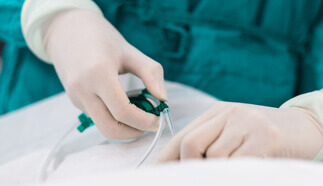<< View SCS Blog
Comparing Lubricious Coatings
Selection of conformal coatings for medical devices takes into account a host of considerations including the operational environment it will encounter when employed. Additional operational/performance factors can also include the chemical, electrical and mechanical compatibility between the coating and the device, and the temperature variation the device is expected to encounter.
Equally important in many cases is lubricity, a coating’s ability to reduce component friction or wear, during use.

As a property of conformal coating, lubricity is expressed by the value of its coefficient of friction, which offers a numeric characterization of how slippery a surface is, with lower values indicating lower frictional resistance. Lubricity is an important consideration in the design, installation and function of disposable medical appliances like cardiac-assist devices (CADs), catheters, guidewires, or stents. Designers keep in mind a variety of considerations throughout the development process which might include the need to reduce insertion forces for certain types of devices, which permits easier navigation throughout the patient’s vascular or other internal structure. This can significantly reduce the potential of puncture damage or severe abrasion generated between the device and tissue surfaces.
Lubricious coatings generally demonstrate a reduction in frictional forces exceeding 90% of that of an uncoated device. In addition, they maintain that level of lubricity for an extended operational period, and are thus essential for specialized medical applications.
Hydrophilic and Hydrophobic Coatings
Lubricity of conformal films is achieved by application of low-friction materials on the matrix surface of implantable medical devices which can limit tissue damage and enhance access to the targeted treatment site within the body. Friction reduction by coatings can be achieved by either wet hydrophilic or dry hydrophobic means.
Most hydrophilic coatings are applied by dipping or spraying the film substance onto the device. They also possess the additional benefit of diminishing the incidence of thrombosis when a catheter or guidewire is used. Unfortunately, many of materials are not entirely safe for patients because their lubricious function can diminish over time, dissociating or dissolving away from the matrix surface, leaving particulates in tissue or the bloodstream.
Hydrophobic conformal coatings provide dry-film lubricity, and include such materials as Parylene and liquid Teflon™ (PTFE). Applied by wet methods, PTFE has a lower co efficient of friction than Parylene. With the requirement to eliminate perfluorooctanoic acids (PFOAs) in Teflon solutions, the industry encountered serious issues with the resulting Teflon films cracking and flaking. Given time, scientists were able to identify modifications to the process that would reduce particulate shedding of the final Teflon films. Shedding has been substantially eliminated with Teflons, however, Parylene can offer better quality dry-film lubricity in many cases, essentially because of its vapor deposition polymerization (VDP) application process, which provides a generally more resilient and pinhole-free protective film that never suffered from the catastrophic issue encountered by Teflons with the elimination of PFOAs.
The Relevance of a Material’s Coefficient of Surface Friction
The coefficient of friction measures of the quantity of resistance a surface exerts on substances moving across it. Static and dynamic coefficients describe the friction forces that are overcome to a) initiate movement against a surface and b) maintain movement against that surface respectively. Ideally, a coating will impart identical static and dynamic coefficients of friction against a surface, eliminating a differential in force to initiate movement and to keep it moving. In syringe technology, a difference between these two is referred to as break-out force, a detrimental property to those who administer injections.
Lubricated surfaces have lower levels of friction. The ideal coefficient of friction for hydrophilically-coated medical devices ranges between 0.01 to 0.1, about the same as ice and often difficult to achieve. Optimally, medical hydrophilic coatings can be applied to a wide range of polymeric and metallic substrates, providing suitable lubricity and biocompatibility.
Dry hydrophobic coatings for medical products have higher coefficients of friction. Teflons range from 0.05 to 0.2, and Parylenes fall in the range of 0.13 – 0.3. In addition to improving components’ lubricity, Parylene films also reduce overall surface tack, with micron-thin biocompatible coating protection, generating outstanding chemical, dielectric barrier and moisture protection for an exceptional range of medical devices and components. These Parylene coatings provide sufficient dry-film lubricity to lubricate implanted medical devices per specification without compromising the devices’ original elasticity.
Selecting the Appropriate Conformal Coating
The advantages of hydrophilic coatings are somewhat compromised by a tendency to generate particulates over time, which can become embedded in tissues or the bloodstream. Hydrophobic Parylene is a comparatively soft polymer that does not flake or dissociate during use, making it a superior option in cases where development of particulate is a concern.
As always, the final selection of a coating material is reliant on the specific medical application and environmental conditions after implant. Hydrophobic Parylene offers a superior option for improved lubricity for metal substrates, selected elastomers like silicone rubber, cables and tubing.

